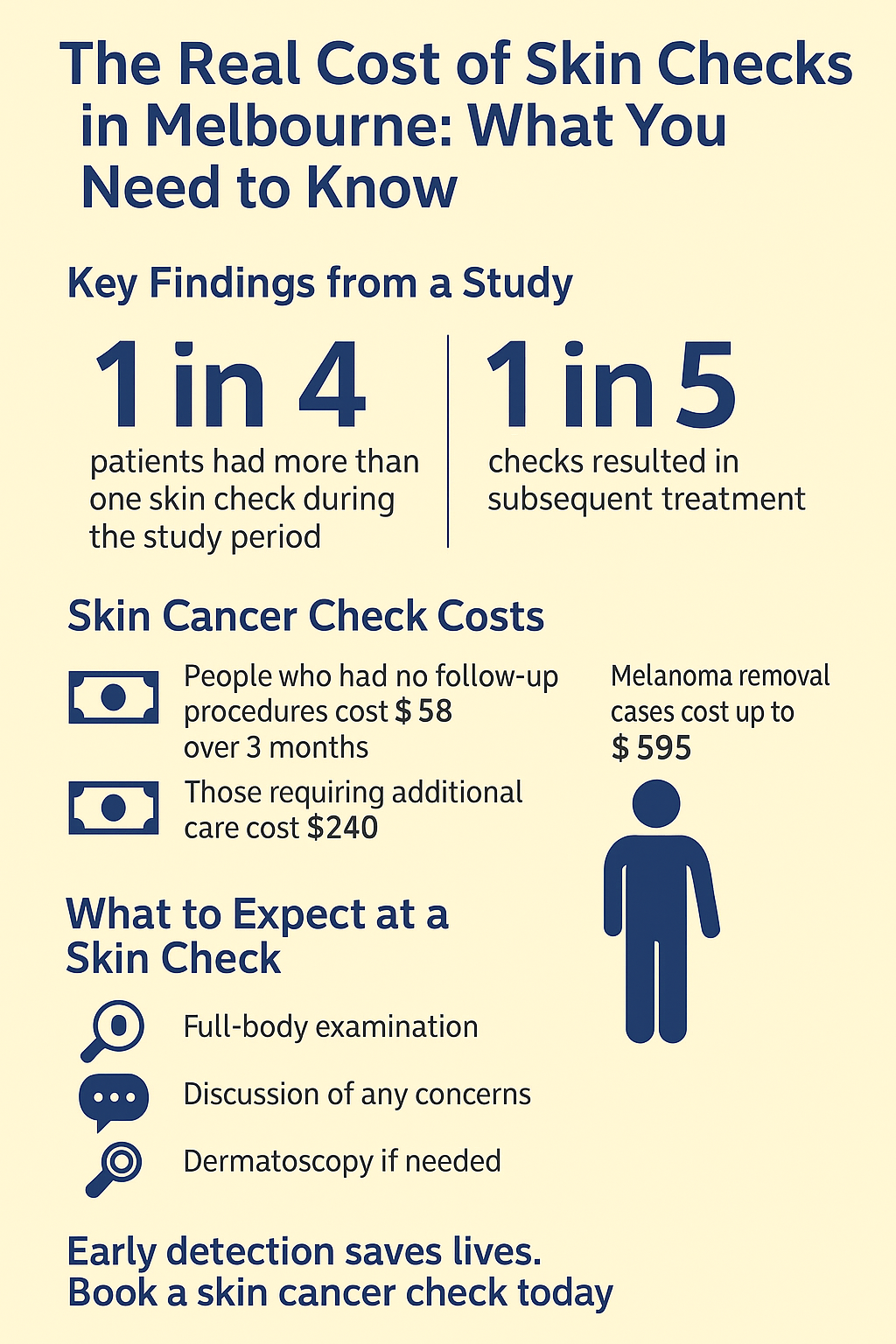The Real Cost of Skin Checks in Melbourne: What You Need to Know
Skin cancer is a serious concern for Australians, especially those living in Victoria. With our sunny climate and outdoor lifestyle, regular skin checks in Melbourne have become more than just routine — they’re a key preventive health measure.
But how often are these checks happening? Who’s getting them? What’s the cost? And most importantly, what happens after that initial skin check?
A new study from Public Health Research & Practice (2024) helps answer these questions, revealing how general practitioners (GPs) across Victoria are performing skin checks and what follows after those appointments — including procedures, treatments, and cost implications.
Key Findings from the Study
Researchers analysed over 59,000 skin check consultations from 73 general practice clinics across Victoria between 2010 and 2017. Here’s what they found:
-
Only 0.7% of all GP visits were skin checks.
-
One in four patients had more than one skin check during the study period.
-
Of those returning, 28% came back within 3 months, while 15% returned after more than 2 years.
-
Within 3 months of a skin check:
-
8% had a biopsy.
-
11% had a skin excision.
-
2% received skin-related medication.
-
5% underwent other treatments, like cryotherapy — often used for sun spot removal in Melbourne.
-
These numbers show that a significant portion of skin checks lead to further treatment. That’s both a good thing — it means potential skin cancers are being addressed — and a cost to the healthcare system.
Skin Cancer Check Costs: What Are We Paying?
The study estimated the average cost to the health system:
-
People who had no follow-up procedures cost around $58 over 3 months.
-
Those who did require additional care cost $240.
-
The most serious cases — where a melanoma was found and removed — cost up to $595.
This highlights a common reality: while many skin checks lead to peace of mind, others uncover hidden dangers that require immediate intervention.
Are Skin Checks Worth It?
From a public health perspective — absolutely. According to Prof. Rodney Sinclair, one of Australia’s leading dermatologists, skin checks offer more than just detection:
-
They educate patients on how to spot suspicious moles or sun spots.
-
They reduce anxiety by ruling out harmless lesions.
-
They help identify people at high risk and guide them toward regular monitoring.
Despite current guidelines advising against mass screening, GPs across Melbourne continue to offer skin checks, especially for patients in high-risk groups — including those with fair skin, a history of sunburns, or a family history of melanoma.
What’s Actually Found During Skin Checks?
Most people visiting a skin cancer clinic in Melbourne will hear about one of the “big three”:
-
Basal Cell Carcinoma (BCC) — common but usually not deadly.
-
Squamous Cell Carcinoma (SCC) — riskier, especially if left untreated.
-
Melanoma — the most dangerous, but highly treatable when caught early.
Skin checks also identify benign conditions like seborrhoeic keratoses or dermatofibromas, which might be mistaken for cancer but don’t require treatment.
Why Skin Checks Should Be a Regular Part of Life
While not every person in Melbourne needs an annual full-body skin check, those at medium or high risk certainly benefit from routine skin cancer screening in Melbourne.
Think of it this way: just like we check our blood pressure or cholesterol, our skin — our largest organ — deserves attention too.
What to Expect at Your Skin Check
Whether you visit a GP or a dedicated skin cancer clinic, a proper skin check should include:
-
A full-body examination (yes, even under your socks).
-
A discussion about any spots you’re worried about.
-
Possibly dermatoscopy, which allows a closer look at moles or lesions.
-
Recommendations for mole removal in Melbourne if something looks suspicious.
Modern clinics may also offer non-surgical mole removal for benign lesions or cosmetic concerns. These options are becoming more popular thanks to laser technology and cryotherapy, especially for warts removal in Melbourne or sun spot removal in Melbourne.
The Takeaway: Knowledge is Prevention
This latest research confirms that skin checks are both common and clinically valuable. With one in five checks leading to treatment, they remain a vital part of Australia’s informal skin cancer detection system.
If you’ve never had a skin cancer check — or it’s been a few years — now’s a great time to book in. Especially with winter approaching, when clinics are quieter and doctors have more time to examine you thoroughly.
Because when it comes to skin cancer, early detection really does save lives.
References
-
Goldsbury DE, McCarthy D, Watts CG, et al. (2024). Skin checks for potential skin cancers in general practice in Victoria, Australia: the upfront and downstream patterns and costs. Public Health Research & Practice, 35, e34122406. https://doi.org/10.17061/phrp34122406
-
Sinclair R. Skin checks. Australian Family Physician. 2012;41(7):464–469.
-
Australian Institute of Health and Welfare. Skin cancer in Australia. https://www.aihw.gov.au/getmedia/0368fb8b-10ef-4631-aa14-cb6d55043e4b/18197.pdf
-
Cancer Council Australia. Clinical guidelines for keratinocyte and melanoma skin cancers. https://wiki.cancer.org.au/australia/Guidelines:Keratinocyte_carcinoma

